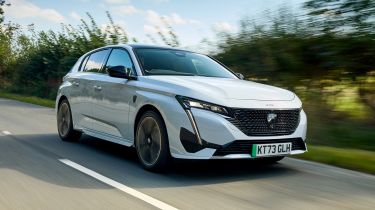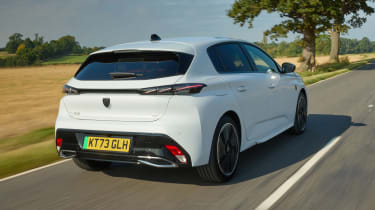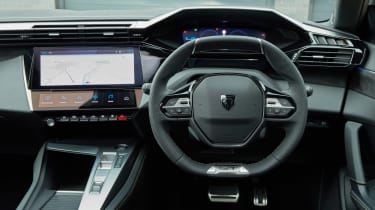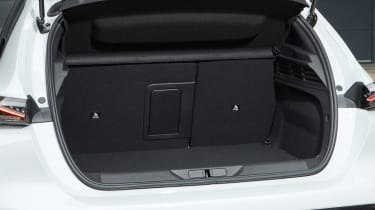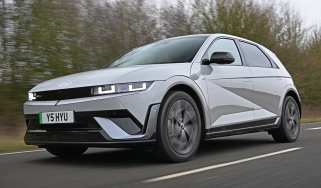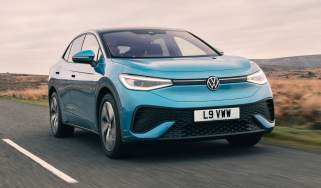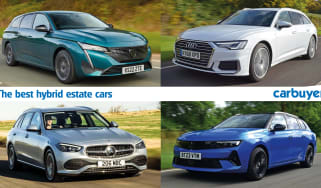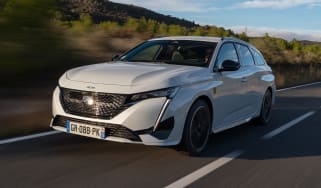Peugeot E-308 review - spacious electric hatchback
“If you don’t mind the van-like looks, the Peugeot E-308 is a great family car with loads of space inside”
Pros
- Quiet and smooth to drive
- Smart looks
- Quality feel
Cons
- Expensive to buy
- Range falls behind rivals
- Fiddly touchscreen
Verdict - Is the Peugeot E-308 a good car?
The Peugeot E-308 retains many of the strengths of the normal Peugeot 308 and builds on them with a quieter, smoother and much more pleasant electric motor replacing the petrol engine. It’s better to drive as a result, although it might be less practical for longer trips thanks to the limited range; the E-308’s rivals can go further on a charge while also costing less to buy in the first place. It also feels a bit sluggish next to many other similar electric hatchbacks and is less practical too thanks to its cramped rear seats. Yet many will still love the E-308’s high-quality interior and bold exterior design.
Peugeot E-308 models, specs and alternatives
The Peugeot E-308 is one of the most eye-catching electric hatchbacks around. Like the normal 308, which uses petrol, diesel and hybrid power, the E-308 features a dramatic grille, unique headlights and sharp body lines to stand out from the crowd.
It needs it when the crowd is this large; there are lots of electric family cars available now including the Volkswagen ID.3, Renault Megane E-Tech and MG4, all of which are direct rivals for the E-308. You might also consider a crossover at a similar price, such as Peugeot’s own E-2008 or the BYD Atto 3. One of the car’s most significant rivals, though, is the Vauxhall Astra Electric, which has a lot of the same technology under the skin as the cars are both built under Peugeot and Vauxhall’s parent company, Stellantis.
More reviews
In-depth reviews
The E-308 and Astra Electric are two of the first electric cars to also be offered in an estate bodystyle; they’re called the Vauxhall Astra Sports Tourer Electric and Peugeot E-308 SW, and they offer a little more practicality than the standard hatchbacks. We’ve reviewed the Peugeot E-308 SW separately.
The E-308 has a 54kWh battery that should provide a range of 267 miles according to official figures, plus 100kW charging capability that can bring the battery from 10 to 80% in about half an hour.
The electric motor drives the front wheels and provides 154bhp and 270Nm of torque. This is a little less than you get in similar rivals, which have around 200bhp and better straight-line performance as a result.
There are no other power options on the E-308 and just two trim levels – Allure and GT. Allure costs just over £40,000 and comes with 18-inch alloys, climate control, a reversing camera, synthetic leather seats with heating, sat-nav, LED lights and Peugeot’s i-Cockpit media set-up. The £42,500 GT model adds a heated steering wheel, sportier styling, Alcantara seats and Matrix LED lights.
|
Trim levels |
Power options |
|
|
Peugeot E-308 alternatives
There are lots of electric family cars available, although most are SUV-shaped rather than a traditional hatchback like the E-308. It does have some key rivals and alternatives to consider when you’re buying, though.
Electric hatchbacks
Electric SUVs
Hybrid family cars
Range, charging and running costs
There’s only one battery and motor option in the E-308, which is a 54kWh battery pack with a 154bhp electric motor driving the front wheels. This allows a range of 267 miles according to official figures, although as with most electric cars you can expect real-world range, especially in winter, to be lower than that.
This means the E-308 falls behind its main rivals. The Volkswagen ID.3 is available with a 58kWh battery for a similar 265-mile range, yet is also offered with a larger 77kWh battery that allows up to 347 miles. The Renault Megane E-Tech’s 60kWh battery pack provides 280 miles of range. These models have more powerful electric motors, too.
Rapid charging at up to 100kW is available in the Peugeot, again behind rivals such as the Renault (130kW), which means you can grab a 10 to 80 per cent top-up in about half an hour. This is useful for longer trips, but home charging will be your main source of fuel and it takes eight hours and 15 minutes at 7.4kW for a full charge. The E-308 is also equipped with an 11kW charger, so if your home wallbox supports this, the car can be charged in just five and a half hours.
It wouldn’t be a big issue that the E-308 has a little less range than its rivals if it wasn’t significantly more expensive than them in the first place. You can get into a VW, Renault or MG for several thousand pounds less, or about £40 a month depending on the PCP deal you choose. The MG4 in particular is significantly cheaper to buy on finance and has lower running costs as a result.
As with all EVs, company car tax is low and as long as your home electricity tariff is suited to overnight charging, it’ll be cheap to run for commuting and local trips.
|
Model |
Battery size |
Range |
|
E-308 |
54kWh |
236-267 miles |
Insurance
Insurance groups are still TBC for the new E-308, but we would expect groups to sit somewhere in the middle of the rating system like similar rivals. Electric cars tend to be more expensive to insure than equivalent petrol models but the Peugeot’s relatively modest power output should help keep prices down.
Electric motor, drive & performance
The Peugeot 308 is good to drive, falling squarely in the middle of the pack for comfort and driving fun in its family hatchback class, in part thanks to its slightly disappointing engines and gearboxes. The E-308 does away with those and is the best car in the range to drive as a result.
Instead of a noisy engine and lumpy gearbox there’s a super-smooth, near-silent electric motor with a single-speed automatic transmission. It means the E-308 is easy to drive and has plenty of performance from low speed, like all EVs.
However, with 154bhp, it’s less powerful than its rivals. The Volkswagen ID.3 has 201bhp, the Renault Megane E-Tech has 217bhp and the much cheaper MG4 has a strong 242bhp motor. Plus, unless you use Sport mode (rather than Eco or Normal) in the Peugeot, you don’t get access to the full power output.
It means the E-308 can feel a bit sluggish if you’re coming from another electric car, although if you’re used to petrol power then its low-speed punch will still be an improvement. From 0-30mph, where you’ll spend the most time if you’re driving around town, it feels lively - but the 0-62mph time of 9.8 seconds shows that the performance dips as you go over that mark.
The E-308 uses the tiny steering wheel you’ll see in most modern Peugeot cars, which is an acquired taste. We have been driving Peugeots with this set-up for years now and some people still aren’t used to it, as the small wheel makes the car feel a little unsettled when you turn into corners. It’s also an odd driving position, with the wheel down in your lap.
The E-308 has a slightly firm ride but it’s not harsh, so it remains quite comfortable over bumps and potholes. Rivals including the Renault Megane E-Tech are better for rough roads, however, and the MG4 is more fun to drive.
|
Model |
Power |
0-62mph |
Top speed |
|
E-308 |
154bhp |
9.8sec |
106mph |
Interior & comfort
Like the normal 308, the Peugeot E-308 is one of the most eye-catching cars in its class. The large grille, detailed LED lights and sharp lines over the bodywork all contribute to the bold look and the electric versions of the 308 all come with 18-inch wheels as standard.
Our favourite thing about the E-308’s design is the interior, though, which is one of the car’s best features. Nearly all its rivals, including the VW ID.3 and MG4, have nice enough cabins but use plastics that look cheap throughout and have a rather plain design overall. The 308 is the opposite: the design of the dashboard and centre console is interesting and unique, while the materials used are high-quality and feel more like they should be in a more premium car like a BMW or Audi.
The seats are excellent too and while we’re still not sure about the tiny steering wheel, the standard-fit digital dials are excellent (you can configure them to your liking) and there’s a 10-inch touchscreen display with quick-access buttons for the key features. This set-up is called i-Cockpit and is shared with many Peugeot cars.
Equipment
While the conventional Peugeot 308 comes in three trims, the E-308 foregoes the entry-level Active, so the lineup starts from Allure specification. That means that as well as 11kW charging capability, all versions of the E-308 come with 18-inch wheels, plus lane keep assist, driver attention alert, a 10-inch touchscreen, smartphone connectivity, digital dials, LED lights and autonomous emergency braking (AEB). Climate control, parking sensors, a heated leather steering wheel, auto lights and auto wipers are all standard-fit in the E-308, too.
There’s also wireless Android Auto and Apple CarPlay and a TomTom sat-nav, as well as heated seats, high-beam assist and remote controls for the heating, so you can warm the car in winter before you get in. The GT model adds Alcantara upholstery, rear cross traffic alert, adaptive cruise control, blind spot detection and keyless go.
Infotainment and navigation
The 10-inch touchscreen media system in the Peugeot E-308 comes with Bluetooth, USB, DAB radio, Apple CarPlay and Android Auto as standard, plus sat-nav and you also get a digital display instead of traditional dials. It’s a good set-up as you can customise the driver display to a certain extent, and the graphics look very modern. Some drivers may find their view of the dials blocked by the steering wheel, though.
The 10-inch screen on the dash uses buttons that give you quick access to key features like the nav, radio and climate control functions. It’s a shame that the Peugeot doesn’t have physical air-con controls, as like in the rival VW ID.3 the fan speed and temperature controls are fiddly to use while driving and are the cause of plenty of frustrations with the system, which aside from this aspect is pretty impressive. It looks good and the screen is responsive enough when you’re not trying to choose menu options while on the move. The lower screen that gives quick access is also configurable, although you can’t use it only for the climate functions, which we would have preferred.
Key features | |
|
Allure
|
GT (Allure, plus…)
|
Practicality & boot space
The Peugeot E-308 (and the normal 308) is a family hatchback, so it’s lower to the ground than an equivalent SUV - in this case, the Peugeot 3008, which is 160mm taller than its hatch sibling. The 308 is also shorter front-to-back, although they’re about the same width. If it’s practicality you’re after, though, you can now buy the E-308 in an estate bodystyle – which we’ve reviewed separately – making it one of the only electric estates on the market.
It’s also more hatchback-like than similar rival models, which will appeal to some buyers: the E-308 is shorter than the VW ID.3 and Renault Megane E-Tech, which both have SUV-like features and are higher off the ground. The Vauxhall Astra Electric is its closest rival in terms of dimensions, since these two models are really similar under the skin as well.
The E-308’s cabin is pleasant but there’s not all that much space in the rear seats. There’s much more space in a VW ID.3, and tall passengers might find the E-308 to be too cramped for a long trip - although it should be fine for kids. There’s a bigger ‘SW’ estate version of the normal 308 but this isn’t available for the electric model.
|
Size comparison | |||
|
Model |
Length |
Width |
Height |
|
Peugeot E-308 |
4,365mm |
1,850mm |
1,465mm |
|
Volkswagen ID.3 |
4,264mm |
1,809mm |
1,564mm |
|
Renault Megane E-Tech |
4,199mm |
1,860mm |
1,505mm |
|
MG4 |
4,287mm |
1,836mm |
1,504mm |
Boot space
The Peugeot E-308 has one of the smaller boots in its class, although at 361 litres it’s still a reasonable size for an electric hatchback. It’s about 20 litres less than a typical Volkswagen Golf you might have driven before, for example, and it’s only two litres behind a key rival, the MG4. However, there are now several models to choose from with much larger boots: the VW ID.3 and Renault Megane E-Tech are both comfortably more spacious for luggage than the Peugeot.
Fold down the rear seats and there’s a total of 1,271 litres which is about the same as in the VW, but this is still less than you get in the Renault. It beats the MG4, though, so overall we reckon the E-308 has merely average space for its class. It also has less space inside than the petrol and diesel versions of the 308, as the large battery pack under the floor reduces the space inside.
|
Boot | ||
|
Model |
Seats up |
Seats down |
|
Peugeot E-308 |
361 litres |
1,271 litres |
|
Volkswagen ID.3 |
385 litres |
1,267 litres |
|
Renault Megane E-Tech |
440 litres |
1,332 litres |
|
MG4 |
363 litres |
1,177 litres |
Reliability & safety
While the Peugeot 308 didn’t appear in the 2023 Driver Power customer satisfaction survey, several cars that share many parts with it did. Most notable is the Citroen C4, which came in first place - and the e-C4 is pretty closely linked to the Peugeot E-308, so reliability and ownership satisfaction should be a strong point here.
Peugeot came in ninth overall in the manufacturer section of the Driver Power survey, and owners praised their cars’ looks, handling and reliability. They were less happy with the layout and usability of the controls in the cabin, which we have to agree with in the case of the 308.
Safety
The Peugeot E-308 hasn’t been specifically tested by Euro NCAP, but the petrol and diesel version has. The organisation notes that the rating doesn’t apply to the E-308, but we can at least use it as a guide to its safety. The 308 scored four stars out of five in 2022, with below-average ratings for adult protection and safety tech. The automatic emergency braking (AEB) was specifically named for being under-par, although it is fitted as standard.
All versions of the E-308 also come with lane keep assist, driver attention alert and a low-speed noise to alert pedestrians. GT models also come with rear cross-traffic alert, adaptive cruise control and lane positioning assist.
Which Is Best?
Cheapest
- Name115kW Allure 54kWh 5dr Auto
- Gearbox typeAuto
- RRP£34,950
Most Economical
- Name115kW Allure 54kWh 5dr Auto
- Gearbox typeAuto
- RRP£34,950
Fastest
- Name115kW Allure 54kWh 5dr Auto
- Gearbox typeAuto
- RRP£34,950

